CLOSE
inspiring you is my passion
REGGIO INSPIRED PRACTICE GUIDE
CONTACT VERONICA
LOOSE PARTS PLAY GUIDE
FREE RESOURCES
PROFESSIONAL TRAINING
FOR ECE'S
FOR TEAMS
from my perspective
this way to the blog!
TOOLKIT
Documentation
Templates
WORKSHOPS
CUSTOM TEAM BUNDLE
FREE TRAINING - POSSIBILITIES OF LOOSE PARTS
shop
CLOSE
inspiring you is my passion
EDUCATOR LIBRARY
CONTACT VERONICA
FREE LOOSE PARTS GUIDE
RESOURCES
PROFESSIONAL TRAINING
FOR ECE'S
FOR TEAMS
TOOLKIT
Documentation
Templates
WORKSHOPS
DIGITAL PD LIBRARY
LIVE WORKSHOPS
FULL DAY PD
FREE TRAINING - POSSIBILITIES OF LOOSE PARTS
New!!!
shop
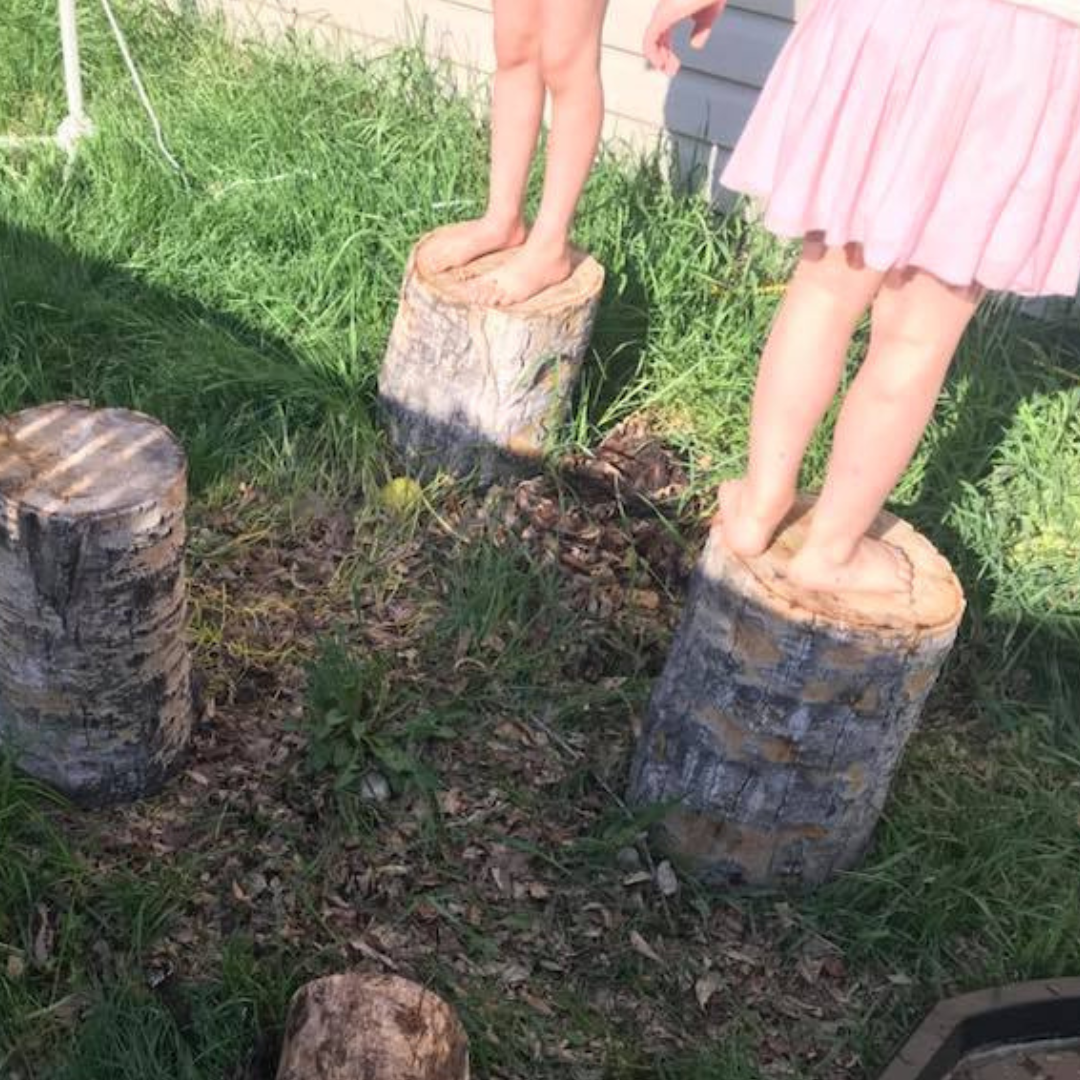
inspiring & practical ideas
GET STARTED WITH
loose parts play
FREE DOWNLOAD
This guide is loaded with ideas, inventory lists, and resources to support you in conveying the learning that is happening while children play!
I only want creativity filling your inbox, so you'll see inspiration and support dropping in...but not too much!
We respect your privacy. Unsubscribe at any time.
All right my fellow educators, it’s time to talk about overcoming barriers to outdoor play!
Outdoor play is a right of passage for children. We all have many memories of coming home when the street lights come on. It seemed the barriers for children to get outside and play were minimal. Most of us have very fond memories of outdoor play.
When we played outdoors as children, we used our natural environments and the materials readily there to create games, make-believe stories and it seemed we went outside for hours to play with such ease. But this doesn’t seem to be the case anymore. There are many barriers that have led to children spending less time outside.
I’ve come across many myths about outdoor play, ones that I too myself have had to break away from in order to bring back the beauty and ease of outdoor play with children. Because with anything you do, your mindset is what will set you up for success.
In this blog post, I want to address the common barriers to outdoor play and provide practical tips and reflection to support you to embrace outdoor play.
And for this, I am calling on the help of my colleague, Christina Pickles from Get Outside and Play! She was a guest speaker inside my online community, The Confident Educator Membership sharing her knowledge and expertise. I am sharing some golden nuggets from this interview to help us…get outside and play!
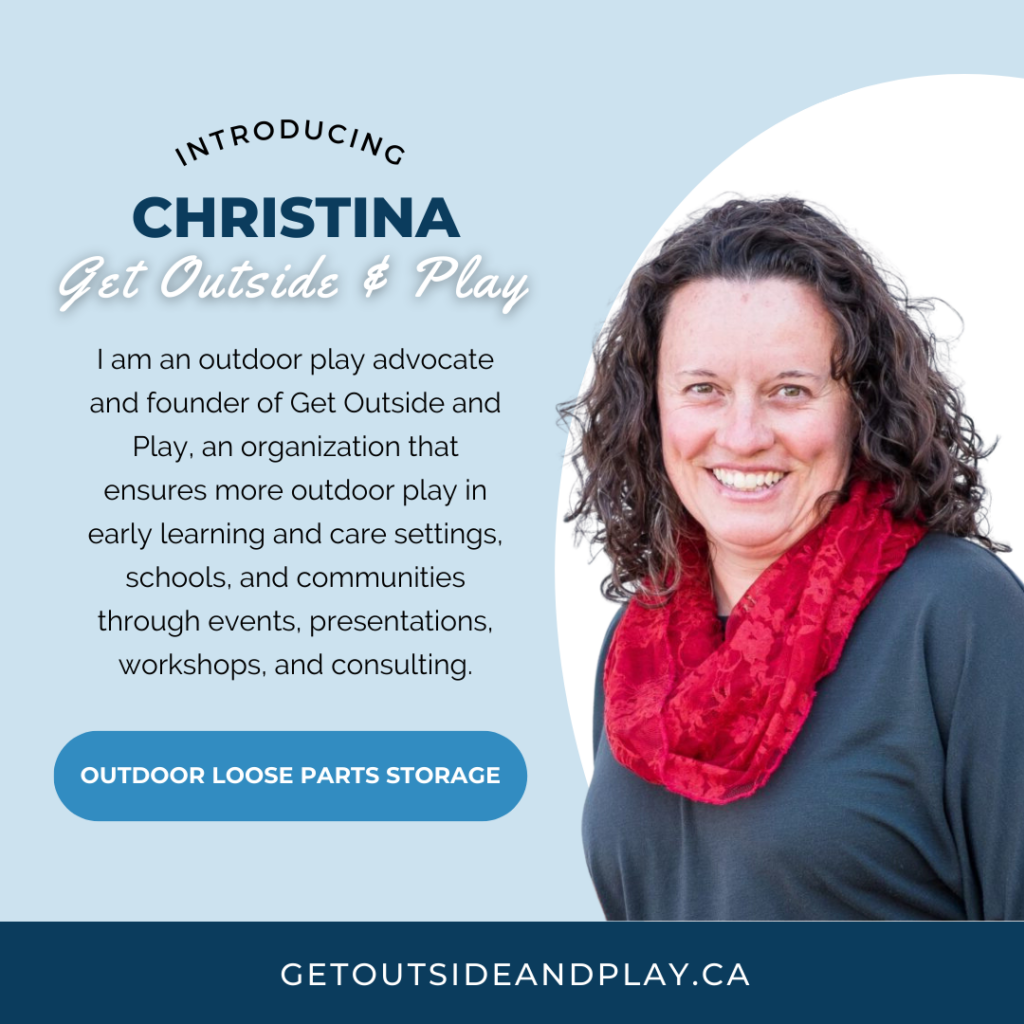
Outdoor Play Barrier #1: “It’s too cold outside.”
Ok, now I live in Winnipeg…known as Winterpeg. I get cold..bone chilling cold. And there are times that it is too cold due to the windchill…BUT that is such a small segment of time compared to weather in general. I know it doesn’t feel like a short period of time when we are in it….but a cold snap typically lasts a week at a time.
Christina is from Alberta and also gets cold weather!
Here’s what she had to say…
“The one number one thing that always comes up is the weather. And yes, it gets cold here, but it’s not cold all the time. There’s other countries where outdoor play happens. People get outside all the time, for example if you look at the Scandinavian countries. And so I think a lot of it is just some of our barriers around how do you dress appropriately for the weather? How do you talk about the weather even with children? You say something’s a bad day, or a good day? What does that look like? So even the language we use around weather is quite impactful. We’re judging the weather.”
The truth:
Yes, weather is a factor to be considered for outdoor play. Yes you have guidelines to follow, but there are many ways to overcome the barriers of it’s too cold.
Mindset about weather and outdoor play is a factor in our abilities as educators to prioritize getting outside. It’s ok if you’re not the biggest outdoor person, I am not either, but our mindsets do impact our actions. Take some time and reflect on how you feel about outdoor play and the aspect of changing weather and temperatures and reflect on how this might be impacting your choice to take the children outside to play.
Outdoor Play Barrier #2: Children don’t have the proper attire.
I can’t tell you how many mis-matched gloves we own. Keeping up with the different outdoor gear needed for growing children is not an easy task. Not to mention close courter cubbies seem to be like a magnetic portal for lost mittens and boots. Parents have busy mornings and forget to bring snow pants. As well as budgets don’t allow for weather proof attire or there are sensory needs that make dressing difficult and managing temperature changes.
Proper attire for outdoor play is a common barrier for a multitude of reasons.
Christina has some practical tips to help support all children in your setting when it comes to attire and the changing weather..
“People say, well, children aren’t prepared for the weather and outdoor gear costs a lot of money. You don’t really need the fancy stuff. If you do start looking online, you’ll be bombarded with Healy Hanson and all these sorts of fancy brands and you don’t need that to go outside. And instead of maybe spending money on a replacement play structure, why don’t we spend that money on getting good gear that stays at daycare? Instead the daycare provides muddy buddies, those zip up muddy buddies. I know programs that have a full class set of those and they put the kids in those. I’m in Alberta, and yes, we have some cold weather, but sometimes muddy buddies with a good fleece layer is all you need.
It’s the waterproofing that’s important. So really thinking, the weather isn’t going away. It’s not changing. We can’t control it. So how can we work with it?”
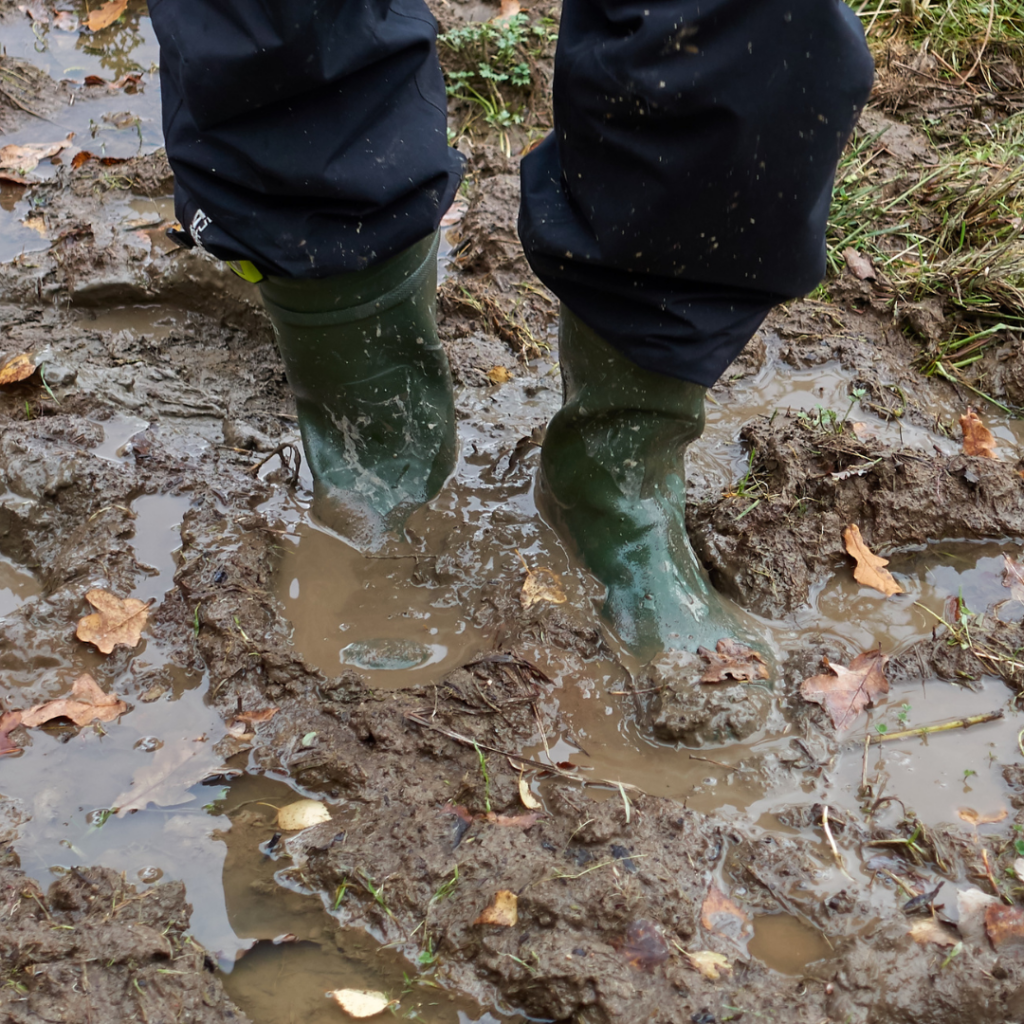
Overcoming Barriers to Outdoor Play – Providing Shelter From Wet & Wind
Here’s another great aspect to consider that Christina shares,
“Providing areas in the cold that provide some wind protection. So I know of one program, used those tents, those sort of carport things. They put one of those in their play space, because it was quite windy. And when it got windy, it was chilly. So they put one of those up for some wind protection. And so the kids went in there for a little bit to warm up, and then they could go back out again. So there are ways that we can be creative, using boxes outside, putting a little blanket in a box that you can kind of warm up in. So there’s ways that you can extend your time outside in the weather, and how you can create little micro environments that help protect you from the weather a little bit.”
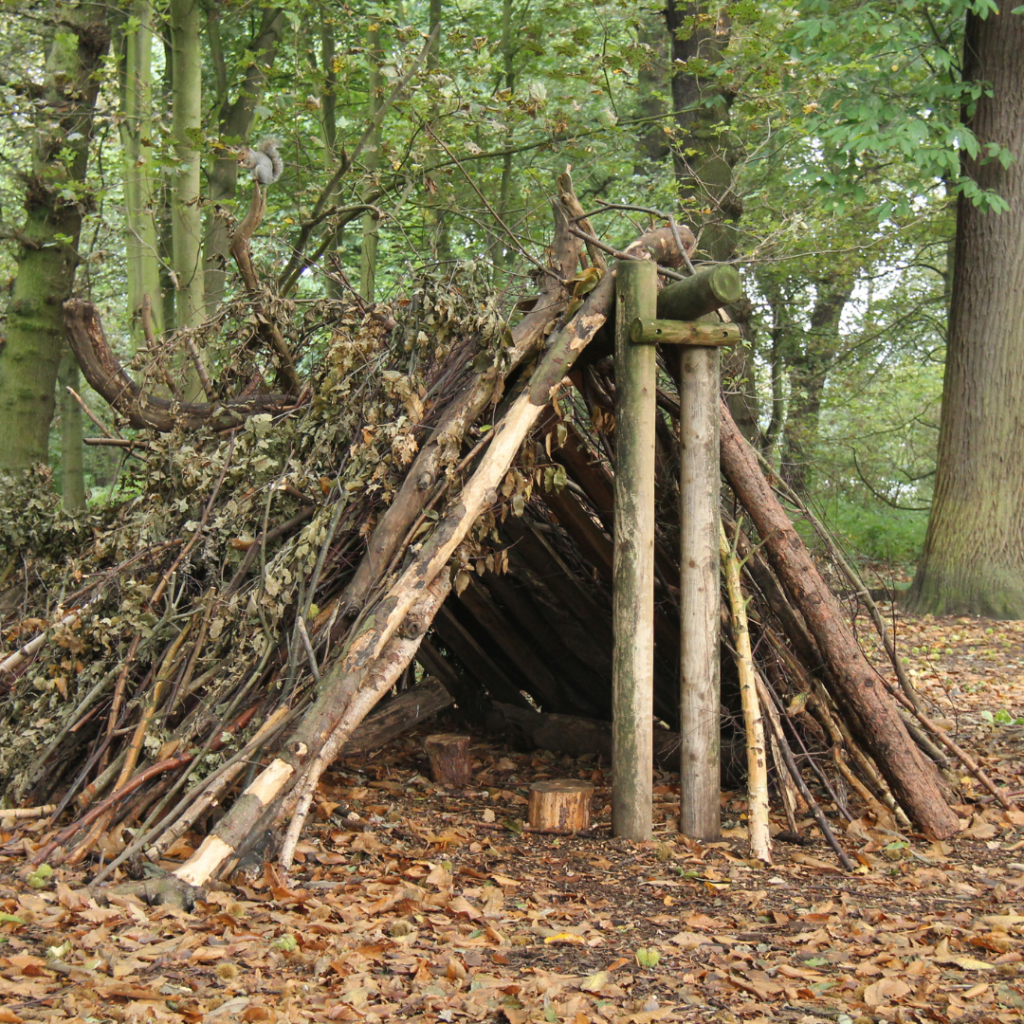
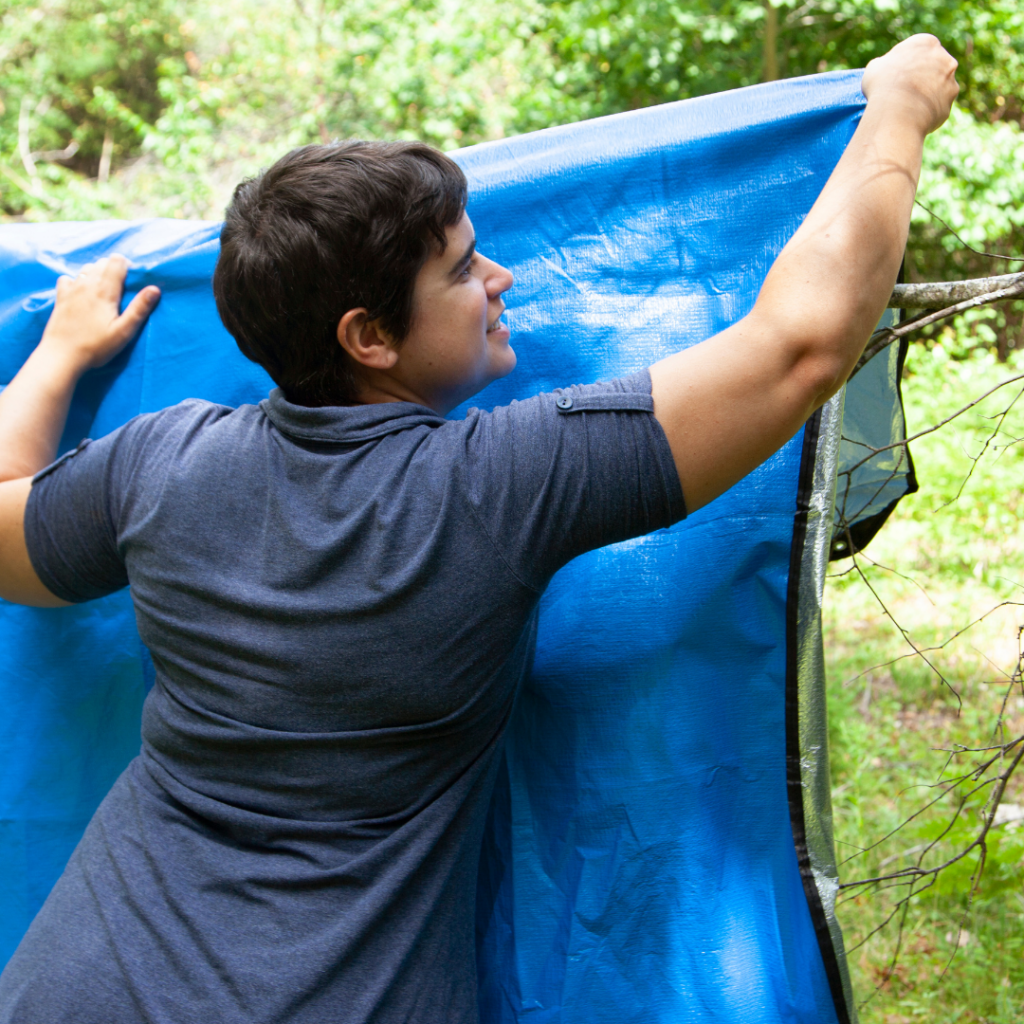
Overcoming Barriers to Outdoor Play – Sensory Needs & Accommodations
I think it’s important to note that protection from wet and wind is also creating an inclusive outdoor play environment. Those with sensory differences and sensitivities may feel the temperature and wind more intensely and can be painful as well. From my experience with our autistic son, sideways rain and wind is painful for him. This is a barrier to enjoying outdoor play and the ability to stay outside for longer periods of time.
Another element that needs to be considered is the bright sun. In the book, “The Reason I Jump” by autistic author Naoki Higashida, states that bright lights can feel like needles in their eyes. Just a simple walk through a parking lot can be painful for our son. Sunglasses are outdoor attire that provide protection from the bright sun and allow him to engage in outdoor play.
And let’s remember that sensory differences and accommodations aren’t just for children, we have many fellow neurodivergent educators.
The truth:
“It’s the waterproofing that’s important” is the key takeaway from choosing outdoor gear that works for any budget and allows children to get outside and play. Wetness brings more coldness and this is what the true barrier is. So consider investing in muddy buddies or likeness, as well as adding tents/tarps into your outdoor space to create micro ecosystems to find relief from the wet and wind. And considering sensory differences to ensure neurodivergent children and educators have the attire they need to engage in outdoor play.
Outdoor Play Barrier #3: Outside play is risky.
I can understand this feeling of outdoor play is more risky as it seems there are more quickly changing elements and hazards to be aware of. But oftentimes our regulations that we have, such as ratios, requirements of first aid kits, regular playground checks do help reduce the hazards.
Risky play or as some educators call it, safe play; does have an important role in children’s development. Risky play is really about developing self-awareness and the ability to judge situations, objects and actions.
Here’s another golden nugget from Christina and her perspective on overcoming this barrier to outdoor play.
“Another thing that comes up quite often in this conversation about outdoor play is that idea of risk. For some reason we think playing outside is very risky. Sometimes we have sticks, and we can climb to heights, and for some reason we think the dangers are higher outside. And that’s another issue that comes up with educators. And it also comes up with parents and sort of what’s dangerous. Children need access to those types of environments to learn and grow and build competence in, in what their bodies can do.”
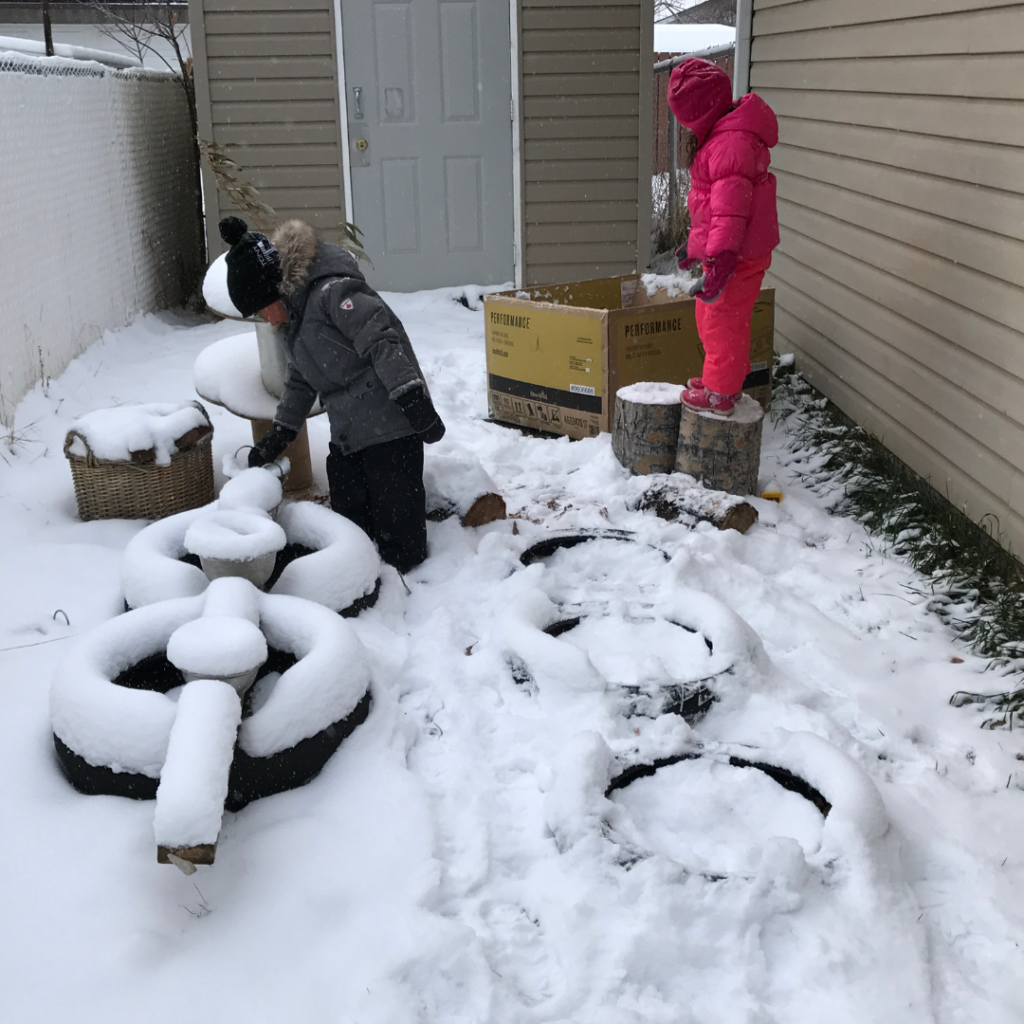
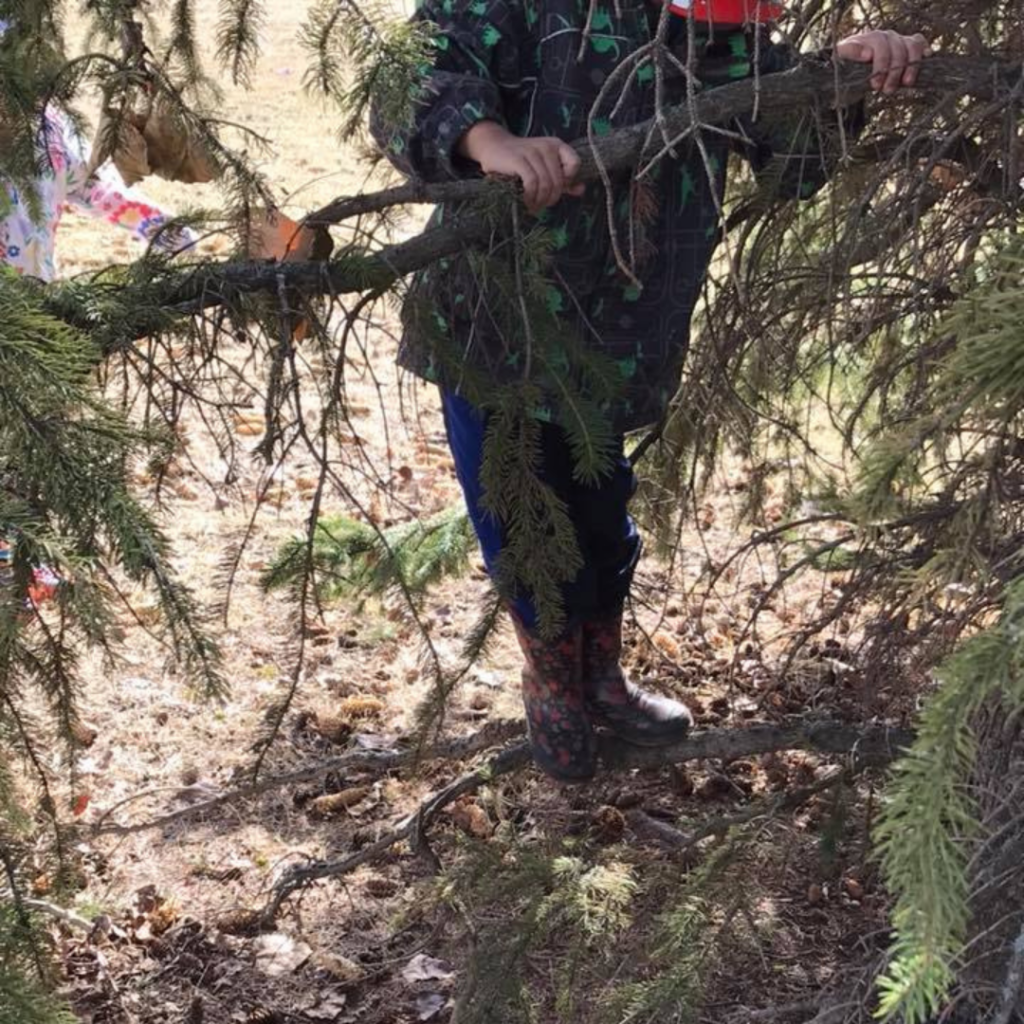
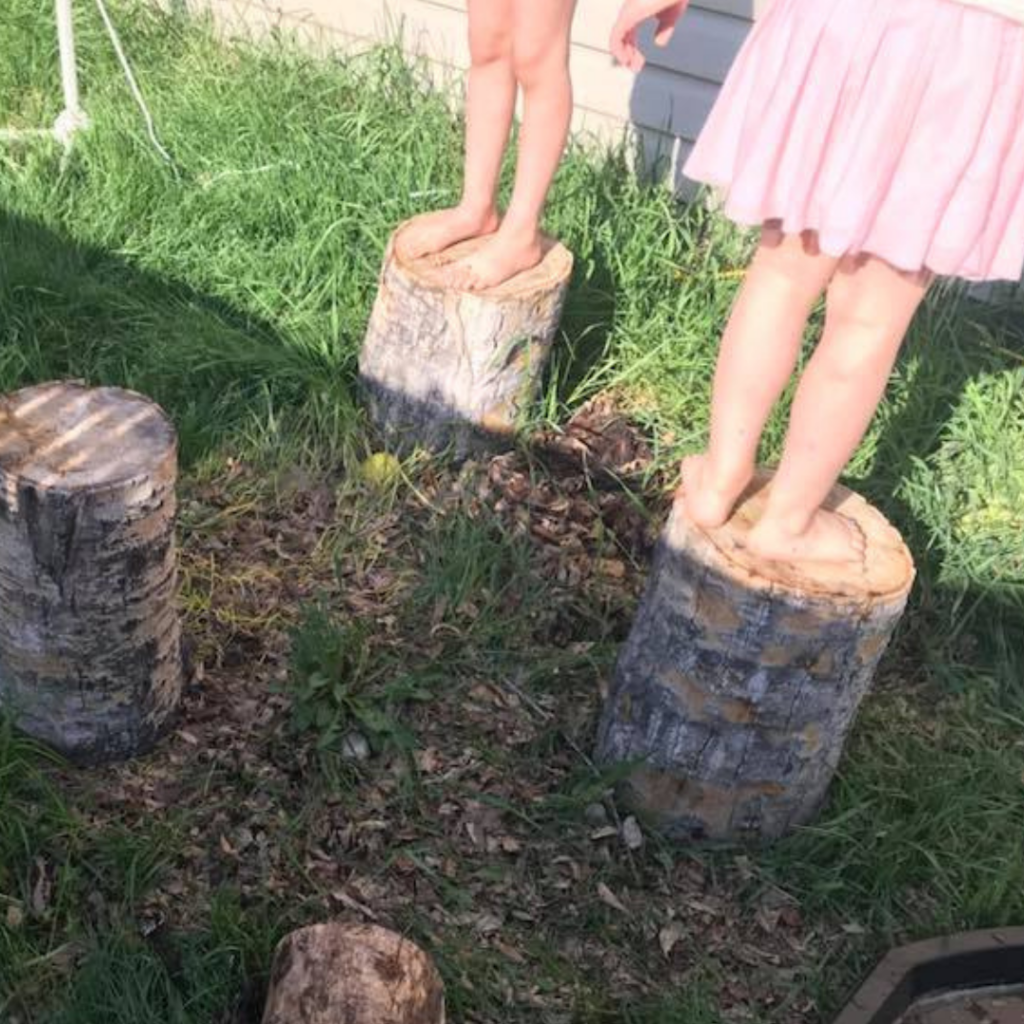
Outdoor Play and Connections To Child Development
Our conversation moved towards the connection between taking risks in outdoor play that help children develop that “gut feeling” and the connections between developing that skill in the early years. The connections between risky play in the early years and what that means for you when you’re a teenager, when you’re in a risky situation.
Christina went on to say,
“So when you’re five, it’s standing on a wobbly board. Yeah, when you’re a bit older, it’s standing on that branch further off on the tree. When you’re 16. It’s driving a car. So you have to scaffold that risk, so they’re ready for that. And we do that with everything else in life. We do that with reading and writing and everything else. We have to do that with how we think about risk as well. And I really like the idea of learning how to listen to your body. That listening to your gut is really important.”
The truth:
Risky play or safe play is a life skill. And in reality climbing trees and walking on wet rocks does have a risk but the real risk is not allowing children the opportunity to develop this skill that connects to judgment and trusting oneself/body later in life.
Reflect on how often you get that gut feeling, do you listen to it? Do you trust it? Where did you develop that awareness and ability to understand it. How does the world and our practices with children hinder or support this skill development?
Why is it important to overcome these 3 barriers to outdoor play?
I think it’s universally known that outdoor play is important for children’s development across all learning domains and for very important life skills. But there are real barriers to getting outside to play, such as mindset, economics, neurodivergence and risk. We’ve addressed 3 common barriers, there are more, but I hope that you can see some potential ways to overcome them and embrace the beauty of outdoor play!
Now you’re ready to start curating an outdoor play mindset and environment that reduces these barriers, next is seeing the possibilities within your outdoor play space, and the loose parts variables just waiting for you and the children to explore with!
Christina and I put together an online workshop called, Loose Parts Play for Indoors and Outdoors. Where you’ll learn how to use loose parts in both your indoor and outdoor environment to curate fluidity in children’s play throughout the day, and how to use loose parts in 4 common ways such as ramps, building, kitchen and fort play for both indoors & outdoors. And more! This workshop is on-demand, including a 1.5. Hour certificate of completion, no time limits, unlimited access and a companion resource guide that will support you in your practice.
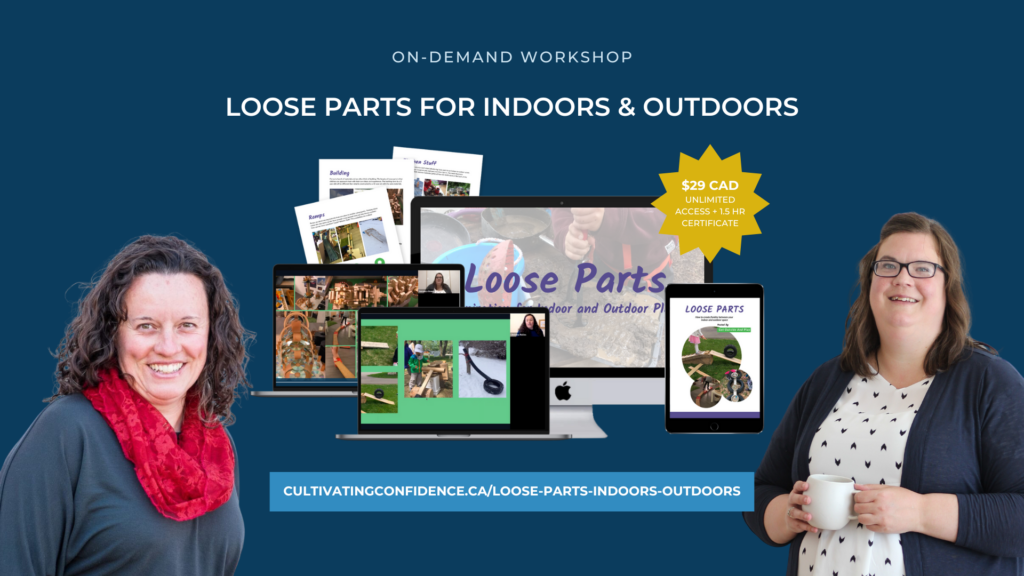
Hey there!
I'M VERONICA
I am an Early Childhood Consultant and very passionate about supporting and inspiring my fellow Educators. I will share my reflections and experiences about implementing my philosophy, views, and ideas into my practice.
COFFEE & BOOK LOVER
find more on
stay connected
Overcoming Barriers to Outdoor Play
Leave a Reply Cancel reply
ENDLESS POSSIBILITIES OF
loose parts play
ON-DEMAND FREE TRAINING
Unlock the possibilities to simplify your planning, become proactive with behaviours & enjoy your role again! I'll guide you to find the beauty in loose parts play.
DISCOVER THE POSSIBILITIES!
I'M VERONICA.
EARLY YEARS CONSULTANT
Here to help you simplify planning, understand behaviours & build strong relationships...all with the magic of loose parts!
ENGAGE YOUR CURIOSITY
MY EARLY YEARS JOURNEY
THE MODERN EDUCATOR TOOLKIT
WORKSHOP (LIVE & REPLAYS)
CUSTOM TEAM PD BUNDLE
POSSIBILITIES OF LOOSE PARTS TRAINING
CONTACT
get your
guide!
Wanna know how to GET STARTED with these magical materials?
find out right here!
back to top
WEEKLY EMAIL
join the
let's stay connected...
Only inspiration & support will drop in your inbox. Unsubscribe at anytime.
CLOSE
I'M VERONICA.
Here to help you simplify planning, understand behaviours & build strong relationships...with the magic of loose parts!
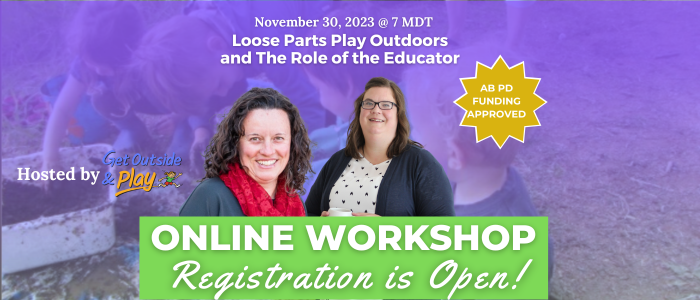
VERONICA
POSTED BY:
also known as Ronnie!
SPECIAL NEEDS MOMMA &
EARLY CHILDHOOD CONSULTANT
Inspiring and mentoring my fellow educators how to use loose parts to enhance all aspects of their practice. I share my dual roles of educator & momma and how our autistic son has shown me so many new perspectives.
read about my early years journey